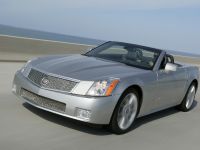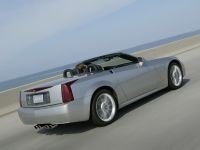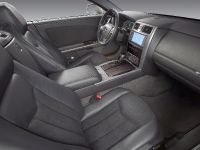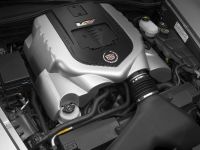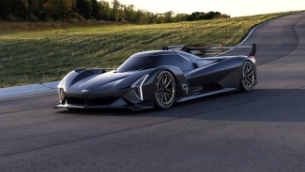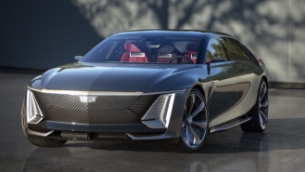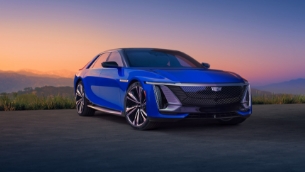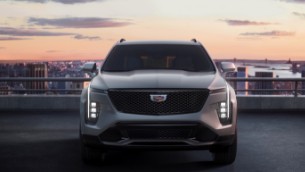Cadillac XLR-V
The Cadillac XLR-V, a recent addition to the luxury nameplate's growing family of high-performance V-Series vehicles, combines luxury with power, performance, personal amenities and style. The XLR-V is equipped with the Northstar V-8 SC (supercharged) engine, producing 331 kW (448 horsepower). Combined with a rear-mounted, six-speed automatic transmission, the XLR-V's supercharged engine helps delivers 0-to-100 km/h (0-62 mph) acceleration in less than five seconds.
Measuring a compact 4.51 meters (14.8 ft.) by 1.84 meters (6 ft.), the XLR is based on the iconic Evoq concept car that redefined the perception of Cadillac around the world. The Cadillac XLR-V shares with the XLR the combination of distinctively bold styling with contemporary luxury, ingenious technologies, rear-wheel-drive performance and near 50/50 weight distribution for enhanced balance and vehicle dynamics – yet it does so on an entirely different performance level.
As with all members of the V-Series family, exterior and interior appointments clearly set the two-seater apart. These include the signature wire mesh grille, larger, 19-inch wheels at all four corners, and Ebony wood and aluminum accents throughout the interior. Chassis refinements enable equal surefootedness and driver appeal on the street or the track, including larger brakes, stabilizer bars, wheels and tires, and a performance-calibrated Magnetic Ride Control (MR) system.
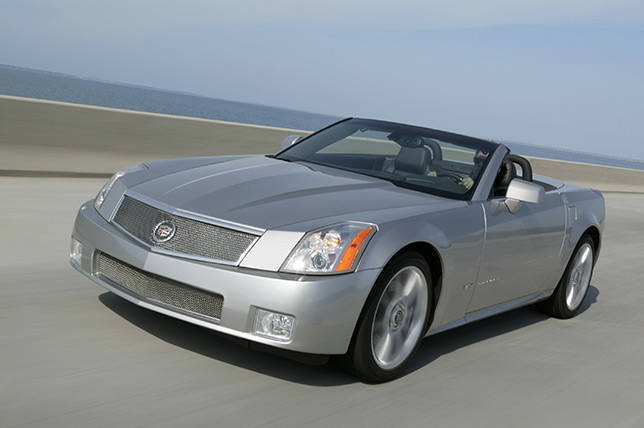
Supercharged Northstar engine
At the heart of the XLR-V is the 4.4L version of the Northstar engine outfitted with an intercooled, positive-displacement supercharger. The dual overhead cam (DOHC) V-8 engine, called the Northstar V-8 SC (supercharged), produces 331 kW (448 hp) at 6,400 rpm and 561 Nm (414 lb.-ft.) of torque at 3,900 rpm – and the engine's performance is reinforced by its ability to deliver 90 percent of its peak torque between 2,200 and 6,000 rpm.
The Northstar V-8 SC generates 124 horsepower (91 kW) and 138 Nm (102 lb.-ft.) of torque more than its naturally aspirated counterpart, while its specific output of 100-horsepower-per-liter makes it one of the world's highest specific output production V-8 engines. However, the Northstar V-8 SC used in the XLR-V is more than just power and torque. The DOHC engine includes variable valve timing that provides outstanding top-end performance while maintaining the expected refinement and quality associated with a luxury marque. The aggressive torque curve enabled by the choice of a supercharged engine gives the XLR-V acceleration capable of placing it firmly in the under-five-second-club for 0-to-100 km/h (0-62 mph) time – a signature capability of V-Series vehicles.
Air induction and exhaust
The air induction system on the XLR-V was redesigned to address packaging needs created by the larger engine and addition of the supercharger. These modifications increased the flow of air to the engine by 30 percent, funneling it from the front air intake over the radiator and to the supercharger via two ducts, which converge into one prior to reaching the supercharger, so that only one mass air flow sensor is required.
The system was designed to be as free-flowing as possible, bringing in the maximum amount of air to the supercharger. Each duct has been carefully tuned to minimize supercharger whine and resonance in order to achieve the most pleasing intake sound quality. The exhaust system features a unique muffler design, which effectively combines the construction of a more conventional muffler with a high-performance flow-through design.
To keep sound levels at a pleasant, throaty pitch during everyday driving on streets and expressways, the exhaust is routed through a series of internal chambers that muffle sound levels. During more aggressive driving, a vacuum-actuated Pierburg valve in the muffler opens to allow straight exhaust flow-through. There are perforations in the pipe to allow dissipation into the other muffler chambers, but the overall effect is to reduce backpressure and increase power.
Six-speed automatic transmission
The Northstar V-8 SC is mated to the Hydra-Matic 6L80 six-speed automatic transmission – the first use of GM's new six-speed automatic in a rear-mounted configuration. The 6L80 uses clutch-to-clutch operation and an advanced, integrated 32-bit transmission controller to deliver smooth and precise shifts. In addition, a wide 6.04:1 overall ratio spread enhances performance and fuel economy.
The 6L80 also incorporates a host of advanced driving enhancement features, including advanced Performance Algorithm Shifting (PAS), Performance Algorithm Liftfoot (PAL) and Driver Shift Control (DSC). PAS lets the electronic transmission controller override the automatic gear selection during closed-throttle, high-lateral-acceleration maneuvers, rapidly downshifting with the release of the torque converter clutch for smooth powering up when the throttle is reopened. PAL minimizes transmission upshifts during closed throttle driving and cornering to maintain the correct gear and alleviate "busyness." Driver Shift Control allows the driver to sequentially shift gears manually via the gearshift lever.
The refined shift feel is enabled by careful electronic calibration of both the engine and transmission. During shifts, power is instantaneously lowered, then ramped back up carefully to make gear changes virtually unnoticeable.
Performance-tuned chassis systems
Chassis modifications on the XLR-V include larger brakes, recalibrated Magnetic Ride Control (MR); larger front stabilizer bar and the addition of a rear stabilizer bar, stiffer rear lower control arm bushings, larger wheels and tires, a power steering fluid cooler and a higher-capacity fuel pump.
The most noticeable change was made in the braking system to assure strong stopping power and smooth, confident brake operation, given the increased power and handling capabilities of the XLR-V. To achieve this, chassis engineers turned to J55 brakes, essentially the same application used in the Z51 Corvette, with larger cross-drilled rotors and high-performance brake linings. Front rotors are 340 mm (13.4 in.) in diameter; rear rotors are 330 mm (13 in.). The thickness of the rotor cheeks on both the front and rear has been increased for added thermal capacity. The brake system incorporates dual-piston front calipers and single-piston rear calipers.
Magnetic Ride Control on the XLR-V has been recalibrated to account for the enhanced handling characteristics the roadster's supercharged performance demands. The system seeks to keep the body on an even plane at all times, giving drivers a comfortable ride by dramatically reducing disturbances to the vehicle body. The MR recalibration – combined with a stiffer front stabilizer bar, the addition of a rear stabilizer bar, and stiffer rear control arm bushings – subtly changes the driving characteristics of the XLR-V when compared to the standard XLR. Another V-Series staple is a four-channel/four-selection mode chassis control system (StabiliTrak), enabling the driver to switch between four stability settings, including a "less-governed" performance mode for the performance enthusiast.
Wheels and tires have been increased in size for enhanced sure-footedness, to 235/45R19 on the front and 255/40R19 at the rear. The tires are Pirelli run-flats.
